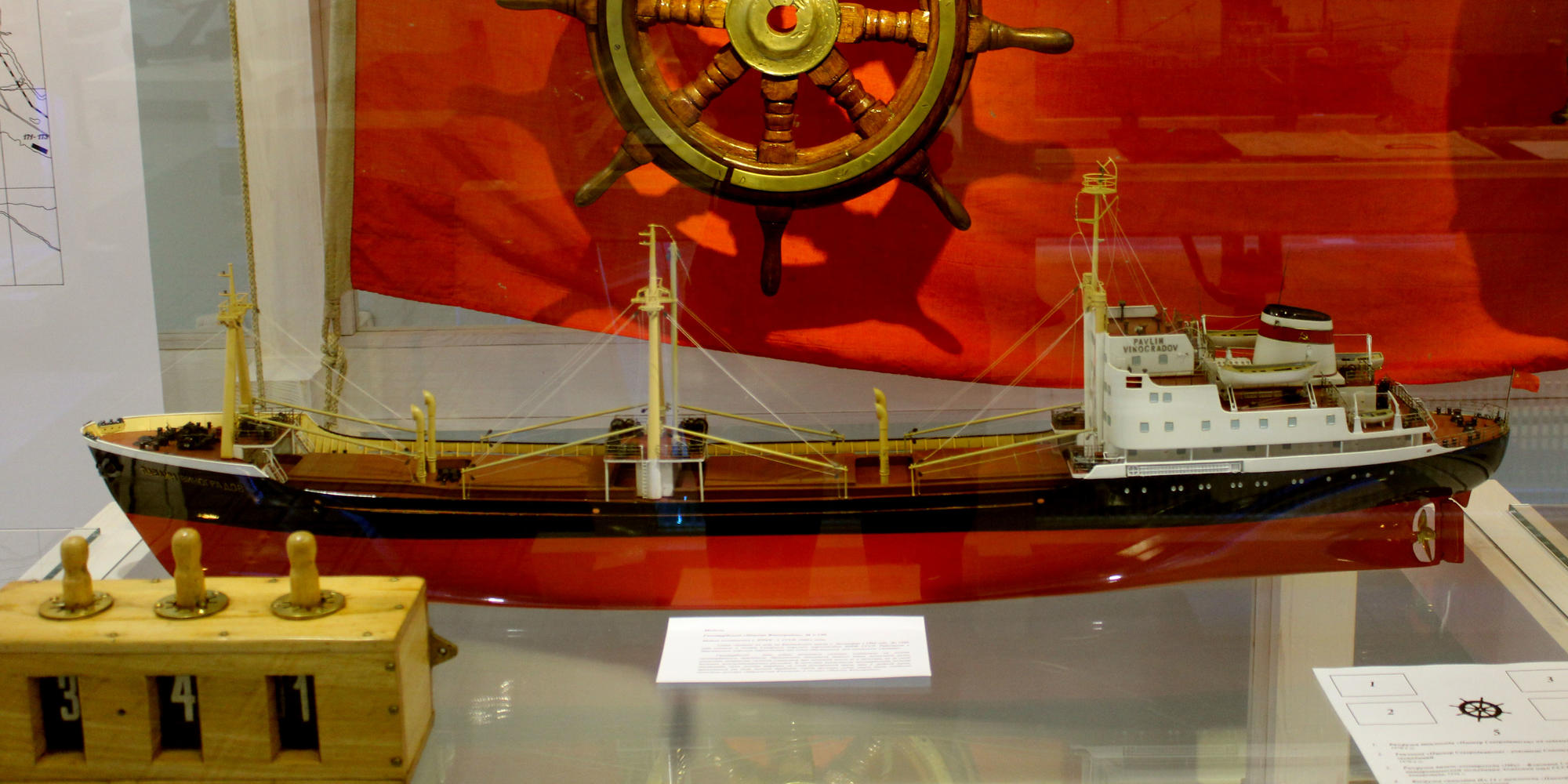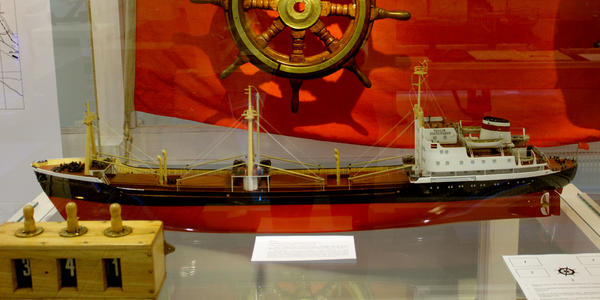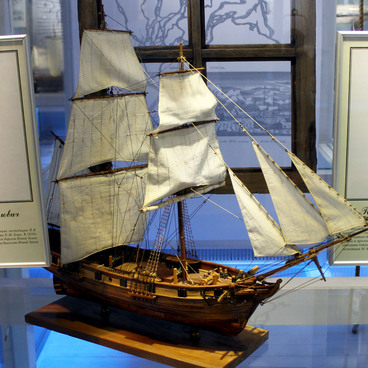A miniature of gas-turbine-powered ship is displayed on the stand. This is a vessel equipped with propulsion based on gas-turbine engine. The prototype of this model became Pavlin Vinogradov, designed by Leningrad Central Design Bureau № 1 in 1960. She was one of a series of timber carriers developed under Project 580 and comprising six vessels.
Main advantage of a vessel with gas-turbine plant is high power at a low weight and compact dimensions; her principle disadvantage is too high fuel consumption. That was ‘the unappeasable appetite’ of gas-turbine plants that became the reason for their limited use in sea-craft. Nevertheless, in the history of national sea and river shipping our passenger gas-turbine-powered ships Burevestnik and Cyclone, timber carrier Pavlin Vinogradov and dry-cargo vessel Parizhskaya Komunna were actively used.
This cargo vessel was named after Pavlin Fedorovich Vinogradov, participant in the Civil War and one of the principal organizers of active struggle against military invaders in the North of Russia. Pavlin Fedorovich was born in January 1890 in the family of a Saint Petersburg salesclerk, studied and worked at the Sestroretsk Plant and also took part in the First Russian Revolution of 1905-1907.
He was arrested in 1912 on the grounds of his anti-imperial position. As a punishment, he was called up for military service in the rank of soldier, where continued his revolutionary propaganda and refused to swear fealty for Tsar. Pavlin Vinogradov was sentences to eight years of hard labor but after the February Revolution showed himself during the storming of the Winter Palace and subjection of the Kroonstad Riot.
Then a mission to the North followed. In 1918 Pavlin Vinogradov went to Arkhangelsk with the party assignment to organize food assistance for Petrograd. The same summer he commanded the operation on liquidation of kulak (prosperous landed peasant) rebellion in Shenkursk Uyezd (district). After that he began the work on establishing North Dvina Flotilla that fought against interventionists and White Guards on the Kotlas axis. Pavlin Vinogradov lost his life in September 1918 in the vicinity of Shidrovo Village.
Main advantage of a vessel with gas-turbine plant is high power at a low weight and compact dimensions; her principle disadvantage is too high fuel consumption. That was ‘the unappeasable appetite’ of gas-turbine plants that became the reason for their limited use in sea-craft. Nevertheless, in the history of national sea and river shipping our passenger gas-turbine-powered ships Burevestnik and Cyclone, timber carrier Pavlin Vinogradov and dry-cargo vessel Parizhskaya Komunna were actively used.
Gas-turbine-powered ship Pavlin Vinogradov has lived a long and interesting life. She was launched at the Baltic Works and operated in the Soviet Northern Steamship Company until 1980. In our days, she has the name Lotta, is a part of the Murmansk Shipping Company and performs functions of a support ship.
This cargo vessel was named after Pavlin Fedorovich Vinogradov, participant in the Civil War and one of the principal organizers of active struggle against military invaders in the North of Russia. Pavlin Fedorovich was born in January 1890 in the family of a Saint Petersburg salesclerk, studied and worked at the Sestroretsk Plant and also took part in the First Russian Revolution of 1905-1907.
He was arrested in 1912 on the grounds of his anti-imperial position. As a punishment, he was called up for military service in the rank of soldier, where continued his revolutionary propaganda and refused to swear fealty for Tsar. Pavlin Vinogradov was sentences to eight years of hard labor but after the February Revolution showed himself during the storming of the Winter Palace and subjection of the Kroonstad Riot.
Then a mission to the North followed. In 1918 Pavlin Vinogradov went to Arkhangelsk with the party assignment to organize food assistance for Petrograd. The same summer he commanded the operation on liquidation of kulak (prosperous landed peasant) rebellion in Shenkursk Uyezd (district). After that he began the work on establishing North Dvina Flotilla that fought against interventionists and White Guards on the Kotlas axis. Pavlin Vinogradov lost his life in September 1918 in the vicinity of Shidrovo Village.



